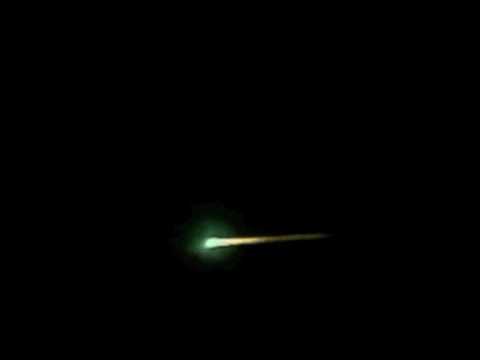Thousands of people saw it, dozens tweeted it, and news outlets from Reuters to the LA Times reported it. What was it? Scientists were quick to declare the bright green object that streaked across the night sky from Phoenix to Los Angeles a near-earth asteroid. From NASA:
Near-Earth Objects (NEOs) are comets and asteroids that have been nudged by the gravitational attraction of nearby planets into orbits that allow them to enter the Earth's neighborhood. Composed mostly of water ice with embedded dust particles, comets originally formed in the cold outer planetary system while most of the rocky asteroids formed in the warmer inner solar system between the orbits of Mars and Jupiter. The scientific interest in comets and asteroids is due largely to their status as the relatively unchanged remnant debris from the solar system formation process some 4.6 billion years ago. The giant outer planets (Jupiter, Saturn, Uranus, and Neptune) formed from an agglomeration of billions of comets and the left over bits and pieces from this formation process are the comets we see today. Likewise, today's asteroids are the bits and pieces left over from the initial agglomeration of the inner planets that include Mercury, Venus, Earth, and Mars.
According to Wikipedia, there have been several other similar reports of Near Earth Asteroids, such as:
On August 10, 1972 a meteor that became known as The Great Daylight 1972 Fireball was witnessed by many people moving north over the Rocky Mountains from the U.S. Southwest to Canada. It was an Earth-grazing meteoroid that passed within 57 kilometers (about 34 miles) of the Earth's surface. It was filmed by a tourist at the Grand Teton National Park in Wyoming with an 8-millimeter color movie camera.On March 23, 1989 the 300-meter (1,000-foot) diameter Apollo asteroid 4581 Asclepius (1989 FC) missed the Earth by 700,000 kilometers (400,000 miles) passing through the exact position where the Earth was only 6 hours before. If the asteroid had impacted it would have created the largest explosion in recorded history, twelve times more powerful than the Tsar Bomba, the most powerful nuclear bomb ever exploded by man. It attracted widespread attention as early calculations had its passage being as close as 64,000 km (40,000 miles) from the Earth, with large uncertainties that allowed for the possibility of it striking the Earth.[41]On March 18, 2004, LINEAR announced a 30-meter asteroid, 2004 FH, which would pass the Earth that day at only 42,600 km (26,500 miles), about one-tenth the distance to the Moon, and the closest miss ever noticed. They estimated that similar-sized asteroids come as close about every two years.[42]On March 31, 2004, two weeks after 2004 FH, meteoroid 2004 FU162 set a new record for closest recorded approach, passing Earth only 6,500 km (4,000 miles) away (about one-sixtieth of the distance to the Moon). Because it was very small (6 meters/20 feet), FU162 was detected only hours before its closest approach. If it had collided with Earth, it probably would have harmlessly disintegrated in the atmosphere.On March 2, 2009, near-Earth asteroid 2009 DD45 flew by Earth at about 13:40 UT. The estimated distance from Earth was 72,000 km (44,740 miles), approximately twice the height of a geostationary communications satellite. The estimated size of the space rock was about 35 meters (115 feet) wide.[43]On January 13, 2010 at 12:46 UT, near-Earth asteroid 2010 AL30[44] passed at about 122,000 km (76,000 mi). It was approximately 10–15 m (33–49 ft) wide. If 2010 AL30 had entered the Earth's atmosphere, it would have created an air burst equivalent to between 50 kT and 100 kT (kilotons of TNT). The Hiroshima "Little Boy" atom bomb had a yield between 13-18kT.[45]On June 28, 2011 an asteroid designated 2011 MD, estimated at 5–20 m (16–66 ft) in diameter, passed within 20,000 km (12,000 mi) of the Earth, passing over the Atlantic Ocean.







